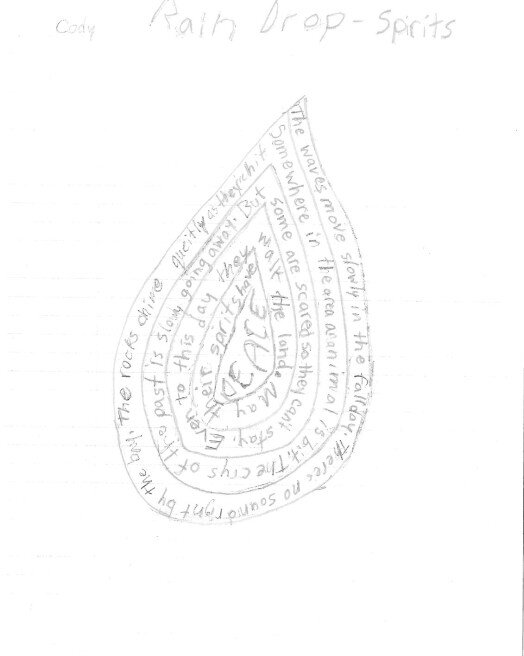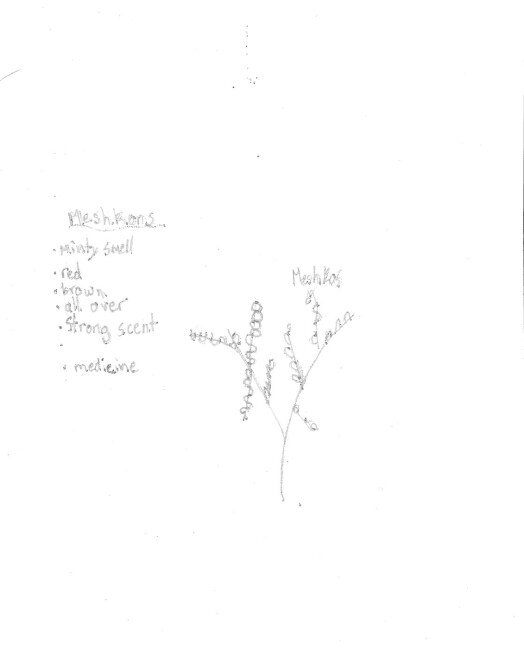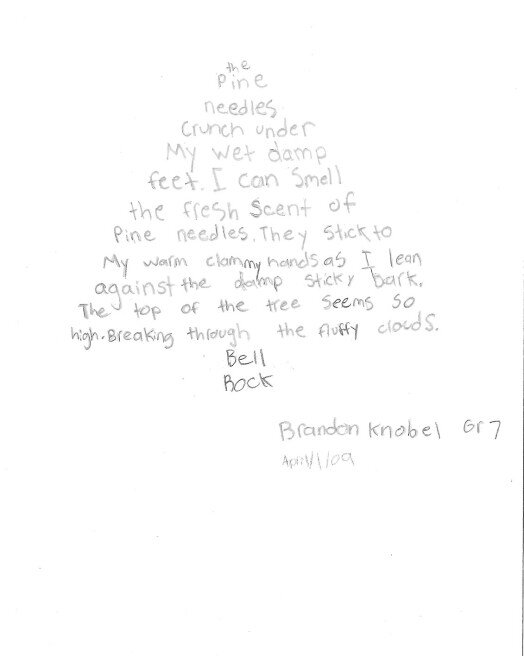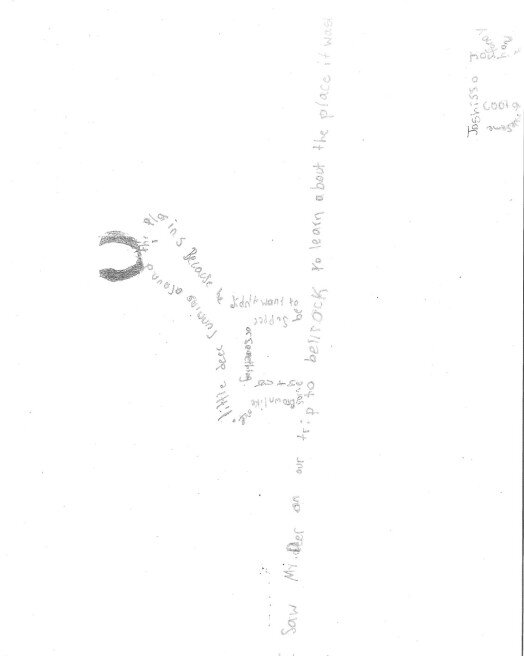THE PROJECT WAS ALL ABOUT EXPLORING THE RELATIONSHIP BETWEEN STORY, WORDS AND PLACE. OVER SEVERAL MONTHS THE GRADES 6 AND 7 STUDENTS AT LITTLE CURRENT PUBLIC SCHOOL LEARNED ABOUT MANITOULIN AND AREA THROUGH LOCAL KNOWLEDGE-KEEPERS, AND THEY PARTICIPATED IN A SERIES OF IN-CLASS WRITING SESSIONS DURING WHICH TIME THEY WROTE POEMS ABOUT BELL ROCK, MANITOULIN, AND THEIR HOMES.
It was raining. The sky was grey. The bus windows were steaming up, but the students filling the full-sized bus were hushed. Esther Osche, a knowledge keeper from Whitefish River First Nation was telling the story of Bell Rock. She spoke of the role of the rocks and how they sounded around the bay, the mass deaths of the men and boys poisoned by a European trader, the dispersal of the women and children, the restriction by the Jesuits to conduct ceremonies and use the rocks and the withholding of supplies for doing so. The rain ran down the windows, and the bus was heating up with all the bodies squashed into the seats. We insisted on going despite the rain. These stories are to be told onsite. This project was all about stories, their relationship to place – the land – and the important role of learning in place.
As Esther finished telling her story, the rain stopped. The students filed off the bus, and began to walk with Esther toward the rocks. The rain and our footsteps released the scent of penny royal beneath our feet. Esther led the students to the rocks, then to the graves, and to the water where the rocks originally sat. We learned about how they were almost crushed and shipped off with other erratics on this flat alvar coastline.
Students walked around the site, and experienced the place through their senses. They were provided with worksheets with ‘cues’ for building their awareness of the place by collecting words for things they see, hear, feel, smell; a chart to note topographical and ecological aspects of the alvar (a very particular kind of landscape), and to map the site. They experienced traditional oral storytelling, at the site of the story, where history, the body, the flora and fauna all co-exist, the story recreating place through the telling.
I designed the project, Telling Stories about Place, to engage students in an exploration of the relationship between story, words and place. Over several months the Grades 6 and 7 students at Little Current Public School learned about Manitoulin and area through local knowledge-keepers, and they participated in a series of in-class writing sessions during which time they wrote poems about Bell Rock, Manitoulin, and their homes. We facilitated a full-day story building workshop with several stations through which all of the students rotated: a listening and sound poem workshop with Hoi Cheu (Film School, Laurentian University) and Sophie Edwards (4e), movement work with Bruce Naokwegijig (Debajehmujig Storytellers), and an improvisational workshop with Bill Shawanda (Debajehmujig Storytellers). Author Joseph Gold provided a talk for the teachers about the role of narrative and story in identity. And the day was capped with the presentation of a new work by spoken word artist Cheryl Kennelly.
Funded by the Ontario Arts Council, the project supported the school’s work to develop a number of independent programs that over the few years prior had increasingly been providing a school- and curriculum-wide approach to learning and teaching that integrated multiple intelligences, cultural approaches and steps to incrementally bring students toward language development and writing. The fundamental questions we were asking students were: what is the relationship between story and place, and what is your relationship to this place?
Sophie Edwards, project curator, curriculum development, writing workshop facilitator
Dr. Hoi Cheu, workshop facilitator, Film School / Centre for Humanities Research and Creativity, Laurentian University
Esther Osche, knowledge keeper, Whitefish River First Nation
Dr. Joseph Gold, independent scholar (Emeritus, University of Waterloo). Author of The Story Species and Read for Your Life.
Bill Shawanda, theatre artist/performer, Debajehmujig Storytellers
Bruce Naokwegijig, movement/performance, Debajehmujig Storytellers
Cheryl Kennelly, spoken word artist




